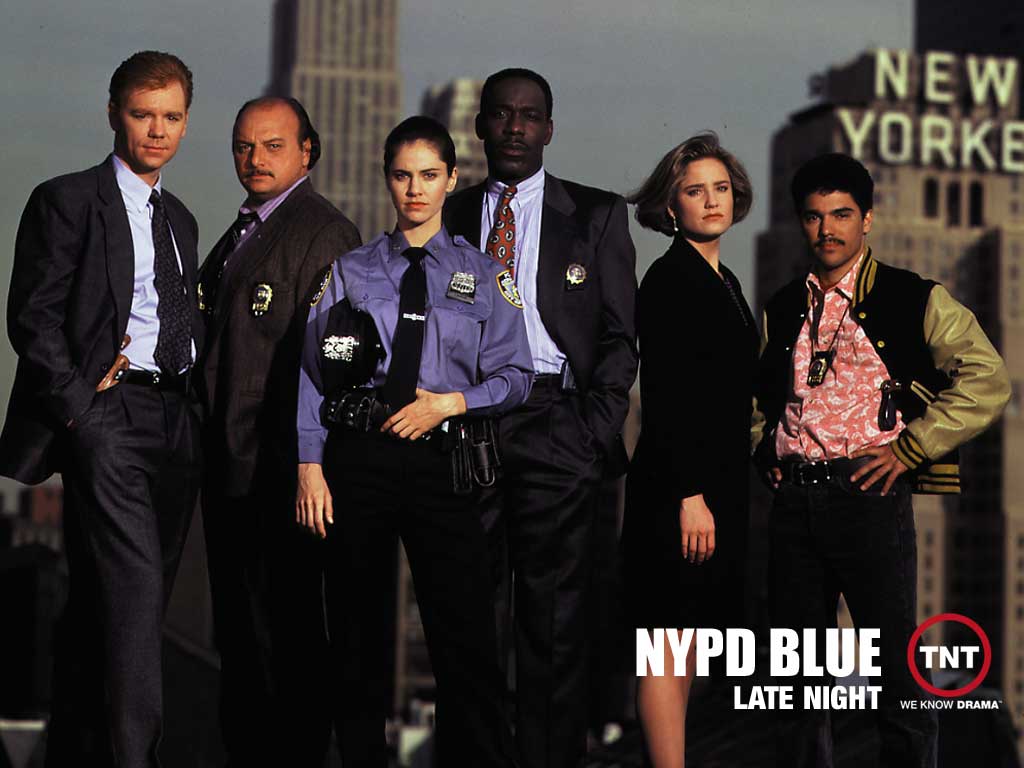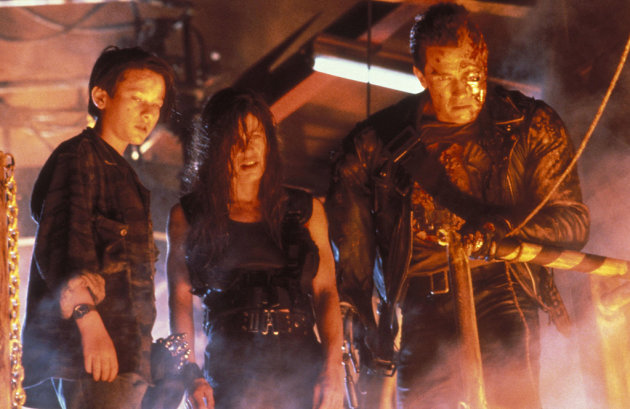NYPD Blue is an American TV programme set in New York City created by Steven Bochco and David Milch. Bill Clark, a former member of the New York City Police Department eventually became one of the show's producers. It explores the idea of not only the cases and the crimes the team face, but the issues that sit internally between team members and family. Each episode follows on from the last and always has a twist to it. Excluding extras, the show generally had 25 actors and 14 management staff.
Camera Shots, Camera Movement, Editing, Sound, Movement, Composition and use of Mise-En-Scene
NYPD Blue employs various camera techniques as an American television police drama. A common shot is featured throughout the series when showing the establishing shot; includes a montage of fast cuts portraying the city in which the show is set in which is also captured by the use of swooping pans and zooms. The use of this camera technique allows the audience to identify with the location in which the series is set. As well as this, it allows the audience to be aware that the size and the hectic nature of the city is which also reflects the nature of the detectives work. In the establishing shot the camera picks out specific locations in New York that the viewer can recognise which creates a sense of realism and invites the viewer to sympathise with the show. The show also creates realism through the use of the diegetic sound of the city, for example cars driving and road works, which makes it more realistic.
A frequent camera movement technique used in the show is panning. It is used on several occasions during the show and creates several effects. Panning camera follow the protagonists as they move through space with occasional use of hand held camera intended to create more dramatic tension. The shakiness of the hand held camera makes the shot more realistic as in real life people view is not still. Panning is also employed to reflect the rushing of the detectives and how fast paced their work is as the camera is constantly trying to catch up with them. As well as this, panning is used during conversation to show the back and forth of ideas between two people and allows the viewer to continuously change their opinion.
Low angles are employed in the portrayal of detectives. The use of this angle heightens the importance of the object photographed, making the viewer perceive the person to be in a position of power and authority. The detective’s position of power is also supported by their black suits, which suggests their mysteriousness and authority. Hierarchy is a key issue explored in the series. It is portrayed by using a common tilt down of the camera which implies a character is coming down to another characters level and vice versa.
The protagonists in the series, which are the detectives, are always portrayed wearing suits which help views associate the show to the genre. As well as this the setting of the offices and the props such as paper work and filing cabinets also informs the viewer what genre the show is. A significant amount of the show is shown in an interior. The use of low key lighting, stereotypical to this genre, sets the atmosphere and mystery and supports the plot as the as the viewer is unaware of the culprit until the end. The use of low key lighting emphasises the viewers’ suspense. Another way suspense is created is by positioning the characters, in particularly the accused, closer to the edge of the frame which heightens the intenseness of the situation and implies they can’t escape from the situation. As well as this, flash cut editing (flashing the screen black) is employed when switching scenes which leaves the previous scene on a cliff hanger and also increases the viewer’s suspense.
Relationships are established by the frequent use of shot reverse shot and over the shoulder shot during conversations. The men in the show stand within social distances of each other which suggest their professionalism and reflect the seriousness of their job. However, some of the women stand within personal distances to other characters which suggest that they are more open to friendship and may suggest that they’re unprofessional. As well as this, while all of the other characters wear black and colours that don’t attract attention, some of the women wear red shirts and crop tops which suggests her sexualisation. This implication that women are unable to carry out their job without using their position as women conforms to the stereotypical perception of women in this genre.
The genre of the show is a drama, following the conventions of Police Procedural. Any Sipowicz, the Sergeant is played by Dennis Franz is typically conventional since the programme does tackle issues of sexism, however, around this time, and in many police dramas, the sergeant always appears to be played by a male, not a female. There are several other sergeants, who all appear to be male, and only 5 or 6 detectives played by females. Even though they are respected throughout the show, the detective is the highest rank that a female plays within the program.
There are many icons that are explored, which follow the conventions of a police drama such as the uniforms, guns and the typical office set up with each member of the team at their own desks full of papers and all have a wired up phone. The higher ranked staffs wear smart clothing, since they are the ones that actually go out and sort the crimes/cases, whereas the people who stay in the office, and deal with administration tend to be dressed more casually, since they do not leave the office and do not have to be concerned about the reputation of their department. The fact that there is an older sergeant running the department converts to the typical ideas that we think of when we think of police dramas, since the fact that an older character is running the department suggests wisdom and experience. Experience seems to be a big icon since the sergeant gives the new people a hard time, making out and assuming that they will be rubbish detectives since they are young, and lack experience. All of the detectives and sergeants wear badges, which again, are another convention, since when we see a badge, we think achievement or authority, and when we think of authority, we think of the police force.
Other conventions such as joking around and arguing are consistent conventions that run through most episodes. When they are in the office, of course there will be quarrels and arguing, this is what we expect from the detectives/ police department, since they are in close proximity and lots of important decisions need to be made, and each individual opinion must be heard; some may be more persistent when trying to have their opinions and ideas heard. However, there is the joking side. These people work every day mostly all day together, and do tend to crack jokes and friendly banter. On the other hand, each individual has mutual support from their other team members, and that support is always there, they never give up on each other. This links into the convention of them going around in pairs or three's. When we think of detectives, we always think of detectives going around in two's, and most of the story line is based around their relationship and how they help each other. The sorts of things that they have to face together, and quite often, their relationship is tested due to the crimes and cases them have to study together.
The name itself, NYPD Blue sounds like a police force. We also associate blue as a police colour, since when there are police cars, quite often there are sirens and blue flashing lights. The fact that it's set in America, also suggests that blue is a colour associated with the police, since their police cars are in fact blue.
These are the main members of NYPD Blue from season 11, left to right, Greg Medavoy (Gordon Clapp), John Clark Jr. (Mark-Paul Gosselaar), Rita Ortiz (Jacqueline Obradors), Valerie Haywood (Garcelle Beauvais-Nilon), Andy Sipowicz (Dennis Franz), Baldwin Jones (Henry Simmons), Connie McDowell (Charlotte Ross), John Irwin (Bill Brochtrup) and Tony Rodriguez (Esai Morales).
In the past, most police detectives were shown as being male in the media, this is still mainly the case although more women are coming to the forefront of what is depicted to be a man’s world. Instead of just getting rid of males as the leading detectives in NYPD Blue, they have found a way of incorporating a female detective as a team amongst the men. The front three are the main characters John, Andy and Connie.
Connie is presented to be tough and is not a detective who feels the need to exploit her femininity in any way when dealing with cases. She is stereotypically good-looking with cleavage and blonde hair mildly subjecting to the male gaze. She is always surrounded by men to give her back up if she is struggling to deal with a male suspect. This now weakens her character as she now conforms to the stereotype that women are gentle creatures while the men are the brute force. As an audience member this was sad to see as her leather jacket suggested her ‘kick ass’ attitude, long trousers with shoes take away her seductiveness and empowers her, as it keeps her flesh hidden. Her stance is much like a male character juxtaposed by her blonde hair, which highlights her potential ‘dumb blonde’ stereotype. However through the seasons we see she is very clever and helps to solve a lot of cases but of course not without the help of a man. She almost represented the social change in the way we should see women in the media. But her lack of prevalence on screen and dependency on men to help her in physical situations slips her back into this still very patriarchal society in which we live in.
Andy Sipowicz is very much the protagonist of the show. He’s the old, fat and bald detective who has seen it and done it all whether its being in the army and fighting in the Vietnam War, having his mother die when he was a boy and his dad being a criminal. Heroes in the media tend to be born from bad situations that have happened in their lives and therefore are scared to end up that way, so turn their lives around. His character does not necessarily represent real life but the audience watch it to entertain and identify with certain views that his character has on the way things should be run, as he is quite old fashioned. He treats the younger generation as rookies, like the way in which he treats John, which can be disrespectful but he does eventually realise his mistakes as a hero should allowing us as an audience to like him again. John being a younger detective looks up to Andy and the confrontations between the two due to male pride and the showing of masculinity can be funny for the audience but again conforms to the stereotype males as full of pride.
NYPD Blue became very famous during its run from 1993 – 2005. It was made for adult viewers as they are more likely to relate to the characters such as the grumpy old man (Andy). The witty banter between the detectives, the way in which the jokes are structured to suit a mature age. Audience identification is key as the male characters in particular create a loveable persona, that don’t always do right at the beginning but (for media purposes which do not represent real life and is more like fantasy) there is a happy ending eventually.




